#Michaeler Platz
Photo

Lothar Rübelt. Perlen der Großstadt (Traffic regulation at Michaeler Platz). Vienna. 1932
Follow my new AI-related project «Collective memories»
#BW#Black and White#Preto e Branco#Noir et Blanc#黒と白#Schwarzweiß#retro#vintage#Lothar Rübelt#Traffic regulation#Michaeler Platz#Vienna#osterreich#Austria#1932#1930s#30s#street photography#Photographie de rue#Strassenfotografie#fotografia de rua#ストリートフォトグラフィー#cities#cidades#villes#都市#Stadtbild#paysage urbain#paisagem urbana#シティスケープ
20 notes
·
View notes
Text
The Night Clerk (2020) film
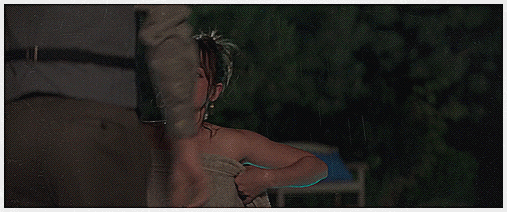
-watched 8/3/2023- 3 stars- on Amazon Prime
#my have seen list#The Night Clerk#2020#film#michael cristofer#thriller/mystery#tye sheridan#ana de armas#helen hunt#john leguizamo#johnathon schaech#jacque gray#stacey ann turner#austin archer#walter platz#joey miyashima#Amazon Prime
5 notes
·
View notes
Text

Danke Micha!!! 🔵⚪️
#seine rolle neben dem platz war nicht immer gut#aber als spieler absolute legende für den verein#🙌🏼💙🤍#hertha bsc#michael preetz
2 notes
·
View notes
Text

The Brave Headmaster: Dr. Erich Klibansky
He saved five entire classes.
Dr. Erich Klibansky was the headmaster of a Jewish high school in Germany who saved dozens of his students by teaching them English and arranging for them to join the Kindertransport to safety in Great Britain.
Born in Frankfurt to a religious family in 1900, Erich was an exceptional student who studied history, German literature and Romanian languages at university. He married Meta David and together they moved to Breslau, where they both taught at Jewish schools. Their son Hans-Rafael was born in 1928, and the next year the family moved to Cologne, where they had two more sons, Alexander and Michael. Erich became headmaster at the Yavne Jewish gymnasium (high school) in Cologne. It was the only Jewish high school in that part of Germany, the Rhineland. Yavne was a co-ed school teaching both Jewish and secular subjects. His wife Meta also worked at Yavne teaching English. The family found a spacious apartment in Volksgartenstrasse, a desirable part of town.
Erich – known to his students as Dr. Klibansky – was immediately popular with students and staff at the school. They appreciated his warm manner and personal interest in every student, as well as his strong leadership at a difficult time.
Germany was in a severe economic crisis, and as a private school Yavne didn’t get any subsidy from the state. Erich’s job as headmaster became focused on fundraising. Motivated to ensure that any Jewish student in Cologne could get a good education despite financial hardship, Erich successfully raised money to keep the school open. As his reputation grew, young Jews started coming to Yavneh from outside Cologne and soon the newcomers made up a quarter of the student body.
As the Nazis came to power in the 1930’s the situation grew grim for Jews in Germany. In 1937 the Klibansky family was forced out of their nice apartment in Volksgartenstrasse and relocated to a tiny flat in a squalid slum. After the Kristallnacht pogrom in November 1938, it became clear there was no future for Jews in Germany. At this point, Erich’s mission as headmaster of Yavne changed. Previously, the school was focused on training the students for exams and university but now the only important thing was survival. He heard about the Kindertransport, an organized rescue effort bringing Jewish children from Nazi-controlled areas to safety in England. Erich determined to get his students on the Kindertransport, and in fact hoped to relocate the entire school to England.
He re-focused the school curriculum to provide intensive English-language instruction for all students in preparation for their escape. Erich reached out to prominent Jews in London and got support for his plan to move Yavne high school to England. The Central British Council for Refugees arranged for the students to stay in a college dormitory.
By summer 1939, Erich was able to send five entire classes of students – a total of 130 people – on the Kindertransport to England. His plan was to get all the students out and then join them in England with his family. However everything came to a halt when war broke out in 1939. The borders were sealed, as was the fate of the Klibansky family and those students who hadn’t left yet. Erich, his wife and three young sons managed to hide from the Nazis until July 1942, when they were arrested and transported to an unknown location. On July 25, the family of five was shot in a wooded area in Belarus and, dying, dumped in a prepared pit.
The brave headmaster’s story has been largely forgotten, but in 1990 a square in Cologne where Yavne high school used to be was dedicated to him and renamed the Erich Klibansky Platz.
For saving the lives of 130 Jewish students, we honor Erich Klibansky as this week’s Thursday Hero.
26 notes
·
View notes
Text
🌟 10th Anniversary Issue on sale now 🌟
Shop today 👉 https://store.beautifulbizarre.net/product/issue-41/
INSIDE ISSUE 41
Exclusive In-Depth Interviews:
Michael Parkes [cover artist], Tamura Yoshiyasu, Tania Rivilis, Andrew Hem.
Articles:
Roxanne Sauriol Hauenherm, Paolo Puck, Known as Myself, Yuki T Photography, Ilya Zomb.
10 Years of Beautiful Bizarre Magazine:
Interview with Beautiful Bizarre Magazine’s Co-Founder and Editor-in-Chief who speaks to us about how the magazine began, how it has grown and evolved over the last decade. Her challenges, successes, learning, and her journey thus far.
Curator’s Wishlist:
Martin & Louise McIntosh, Directors of Outre Gallery in Melbourne, Australia share what they would like to add to their personal collection.
Collectors Profile:
Kim Larson & Bradley Platz, Directors of Modern Eden Gallery speak to us about their personal collection and what motivates them to collect contemporary art.
Lookbook:
Full page reproductions of Nona Limmen’s dark surreal photography.
Quick Q&A:
Lou Benesch, Loputyn, Petite Doll, Karen Turner, and Win Wallace [2022 Beautiful Bizarre Art Prize, Honourable Mention], all respond to the same 4 questions which delve into their artistic practice.
Beautiful Bizarre Artist Directory:
Discover exceptional, innovative and skilled artists from around the world with Beautiful Bizarre Artist Directory – the leading platform for connecting with top talent.
Inside this issue: Jon Ching, Adrian Cox, Iness Rychlik, Elizabeth Winnel, Ransom & Mitchell, Dawid Planeta, El Gato Chimney, Tran Nguyen, Daantje Bons, Troy Brooks, Hannah Yata, Mothmeister, Josh Dykgraaf, Reuben Negron, Amahi Mori, Stephanie Rew, Jeff Echevarria, Bill Mayer, Akishi Ueda, Adam Matano, Brian Viveros, Annie Stegg Gerard, Eunpyon, Marcela Bolivar, Lindsey Carr, Ebony Russell, Hannah Flowers, Theodora Capat, Erik Mark Sandberg, Sara Gallagher, Brittany Markert, Adrian Cox, Bill Mayer, Beth Mitchell, Aaron Mcpolin, Nicolas Bruno, Steven Kenny, Allison Reimold, Adam Matano, Hiroshi Hayakawa, Lexi Laine, Hannah Flowers, Ema Shin, Heidi Taillefer.
Some of our Favourite Things:
We share some of our favourite artisan fashion designers including: Louise Gardiner Embroidery, Ellen Rococo, Yu Tanaka, Jingyi Xiexie, and Sandra Mansour.
Our Community:
Our Instagram #beautifulbizarre community feature including: @candiceghaiphotography, @christina.ridgeway.art, @julyhendrix, @marieeve_proteau, @petulantpretty, @vasilisa.romanenko, @margosimms, @thisiscraves
#beautifulbizarre #artmagazine #art #painting #drawing #photography #sculpture #digitalart #fashion #artinspiration #artist
33 notes
·
View notes
Text
Von Kirchen, Klöstern, Kathedralen
Bulgarien zum Niederknien
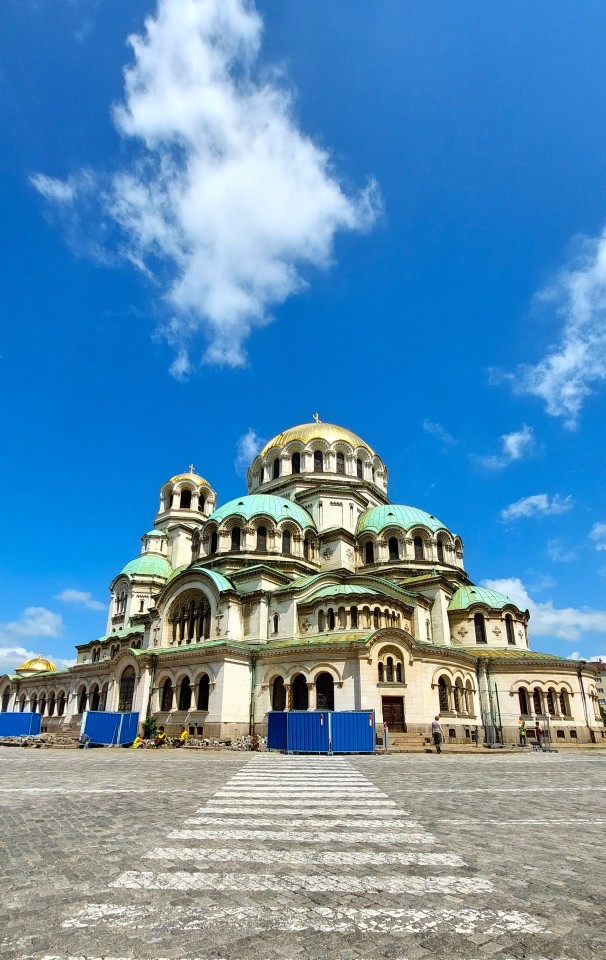
Alexander Nevski Kathedrale
Das Kloster Rila

Das Rila Kloster
Inmitten von Braunbären, Blaubeeren, Raubvögeln und Wölfen, im wirtlichen Wald in der Gegend um Rila, heutzutage zwei Autostunden von Sofia entfernt, vor tausend Jahren abseits der Welt, lebte einst der Eremit und Mönch Ivan Rilski. Bewundert und befeindet von den Menschen umliegender Gehöfte, fristete er ein karges Leben, das hauptsächlich aus Gesprächen mit Gott bestand, später aus dem Heilen Kranker.
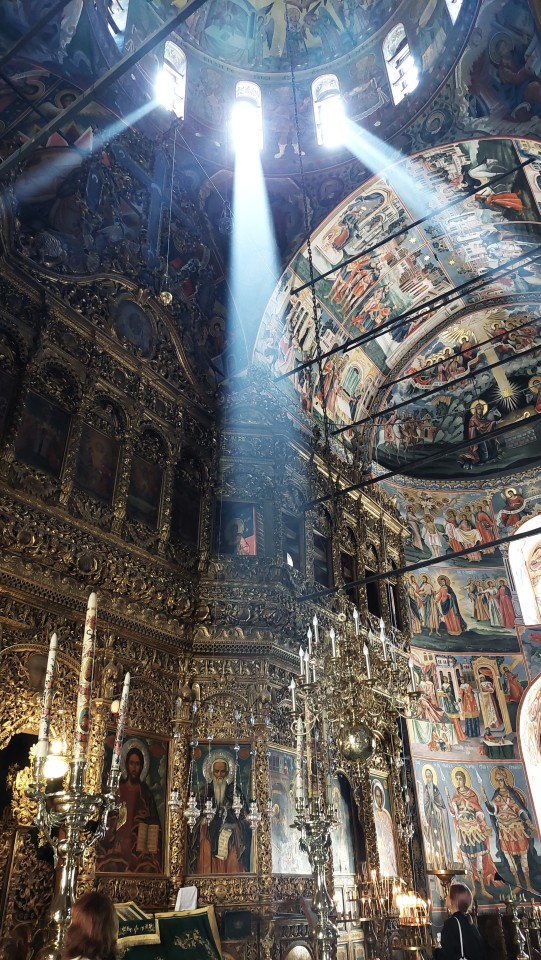
Die Magie der christlichen Kirchenkunst
Bald schon sprach sich die Kunde seiner heilsbringenden Konsultationen herum. Kranke wurden gesund, Siechende fanden zum Leben zurück. Aus anfänglicher Ablehnung wurde Bewunderung, Anbetung. Auch Majestäten fanden den Weg in den Wald. Das heilsbringende Mönchlein wurde landesweit bekannt. Legenden sprechen sich schnell herum und werden zur Wahrheit – so man dran glaubt. Und das taten die Bewohner rund um Rila. Die Kunde sprach sich kreuz und quer im Karpatenlande herum. I, Laufe der Jahrhunderte geriet die Klause zum geistlichen, kulturellen Zentrum des bulgarischen Balkans.

In anderen Welten
Weder die Osmanen, noch die Griechen, schon gar nicht die Nationalsozialisten oder Kommunisten konnten das im Wald versteckte Kloster dem Erdboden gleichmachen, obwohl sie allesamt nicht unbeträchtliches Interesse daran hatten. Das Corpus delicti übertauchte Brand und Brandschatzung. Nicht mal die Kreuzfahrer der Neuzeit, die Touristenmassen, können dem prachtvollen Kulturschatz an den Kragen. Allerdings – die Besatzung des geschichtsträchtigen Klosters, einstmals rund vierhundert Pax, schrumpfte im Laufe der Zeit dramatisch. Heute leben nur mehr sieben Aufrechte hinter den immer noch frommen Mauern. Sogar das Umfunktionieren der Mönchszellen zu preisbrecherischem Airbnb-Angebot schmälert die christlich-orthodoxe Bedeutung der Klosteranlage nicht. Wer frei von weltlicher Begehrlichkeit ist, der werfe den ersten Stein. Auf jenen Frommen freilich wartet man hier schon seit langem vergebens.
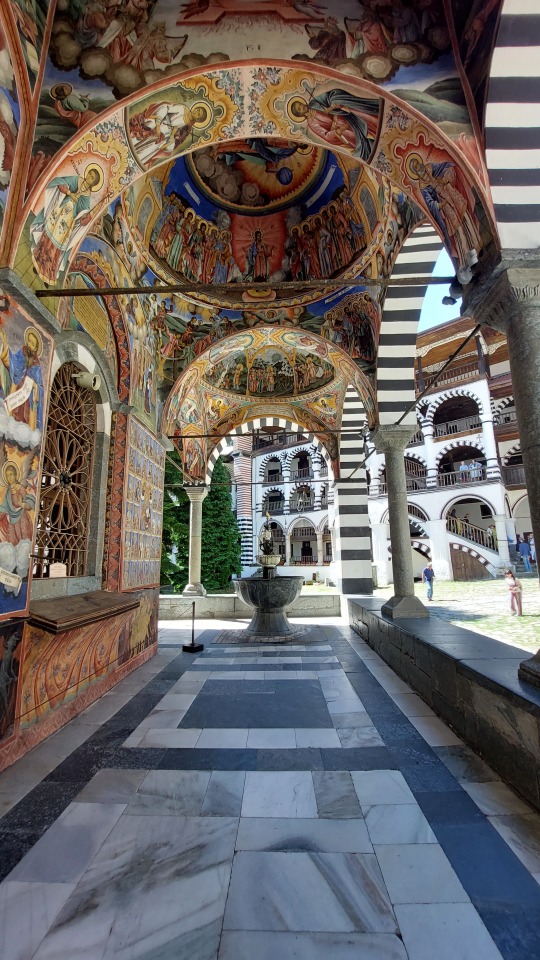
Der prächtige Säulengang
Kirche der Sieben Heiligen
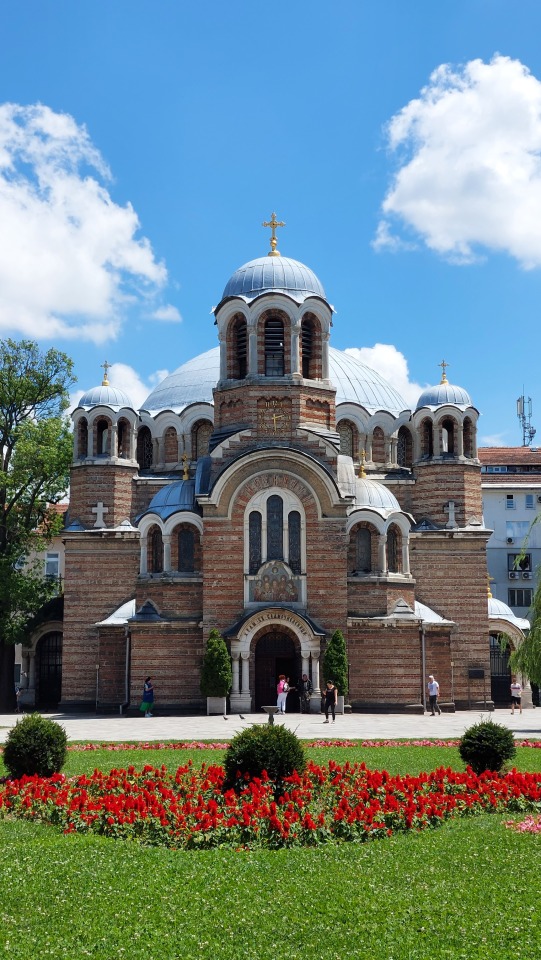
Kirche der sieben Heiligen
Eine ganz andere Geschichte erzählt das Gotteshaus der Sieben Heiligen, nahe dem Slaveykov-Platzes, Ecke Graf-Ignatiev-/Ecke Ivan-Shishman-Straße. Die schöne Kirche ist zwei Männern geweiht, deren Wiege in Thessaloniki stand und die ihr Leben der christlichen Missionierung slawischer Völker weihten, im neunten Jahrhundert kein leichtes Unterfangen. Die beiden Brüder Konstantin und Michael machten Karriere: Sie wurden zu verehrungswürdigen „Slawenaposteln“ und Heiligen – und entwickelten ganz nebenbei die glagolitische Sprache und die kyrillische Schrift. Man hat ihnen ein würdiges Angedenken gewidmet. Das Denkmal der beiden Pioniere in Sachen Christentum und Buchstaben, Kyrill und Method, hat einen würdigen Platz. Es steht vor der imposanten Nationalbibliothek. So wachen die Beiden für alle Zeiten über Millionen von Büchern. So soll es sein.

Kyrill und Method
Basilika Sveta Sophia

Basilika Sveta Sophia
Vor dem roten Backsteinbau einer der ältesten Kirchen Osteuropas, steht ein erstaunliches Monument. So ehrwürdig alt das Gotteshaus auch ist, es datiert bis in frühchristliche Zeit zurück, so jung ist das Standbild von Zar Samuil, seines Zeichens einer der letzten Könige des 1. bulgarischen Reiches – wurde es doch erst im Jahre 2014, hier, auf geweihter Erde errichtet. Der unerschrockene Krieger Samuil bestritt unzählige Gefechte gegen das damals übermächtige Byzanz, die Metropole Ostroms. Vierzig lange Jahre währte die kriegerische Auseinandersetzung um Macht und Einfluss. Der tapfere Zar gewann und verlor. Die entscheidende Schlacht fand im Südwesten Bulgariens, an der Grenze zu Griechenland statt. Fünfzehntausend seiner Krieger wurden gefangen genommen und ihres Augenlichtes beraubt. Als Geblendete kehrten sie zu ihrem geschlagenen König zurück. Beim Anblick der Blinden soll Samuil einen Schlaganfall erlitten haben, an dessen Folge er starb.

Die Augen des Zar Samuil
Der Künstler, der seine Statue schuf, hat dem bronzenen Zar ein Augenpaar verpasst, das in der Dunkelheit leuchtet. Manche Sofioter empfinden dies als Kitsch, andere als Kunst. Gewiss ist eines: Hätte Samuil zu Lebzeiten einen solch scharfsichtigen Durchblick gehabt wie sein erkaltetes Ebenbild, seinen Soldaten wäre einiges erspart geblieben.
Der lächelnde Christus
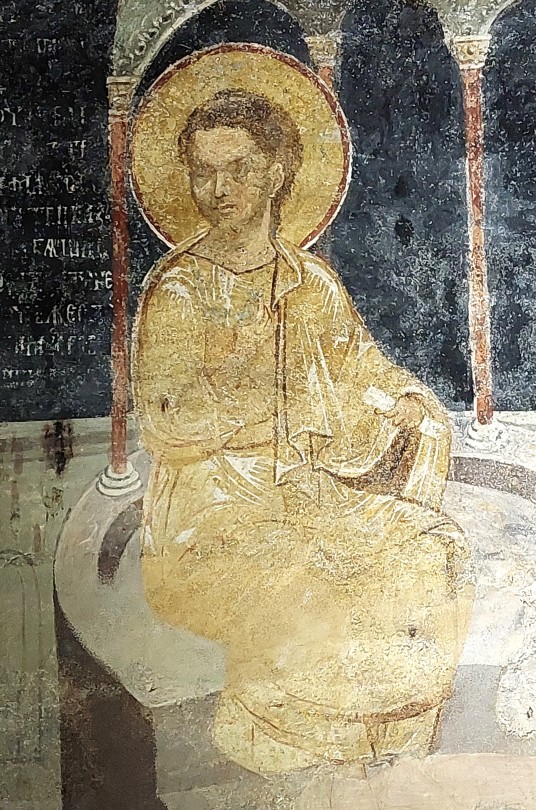
Der lächelnde Christus
Am Hügel der Schönen, Reichen und Korrupten, im Stadtteil Boyana am Fuße des Vitosha Gebirges steht ein äußerlich unscheinbares Gotteshaus, das es, im wahrsten Sinne des Wortes, in sich hat. Die vielfach erweiterte Kirchebeherbergt die wohl schönsten Fresken, die ich jemals zu Gesicht bekam. Inmitten eines exotischen Gartens steht die Trouvaille. Das Außergewöhnliche ist, dass die hier dargestellten Herrscher und Heiligen keineswegs idealisiert, sondern naturgetreu dargestellt sind. Selbst Jesus Christus trägt die Züge eines anmutigen Teenagers. Ich hätte nicht gedacht, dass ich Gottes Sohn je so ansichtig werde. Seine Gestalt ist schlank, in der Linken hält er eine Schriftrolle, die Rechte greift sich ans Herz, der etwas weltfremde Blick ist fragend, zweifelnd – beinahe lächelnd. Allein des Ausdruckes auf dem Antlitz des Allergnädigsten wegen hat sich der Ausflug gelohnt.
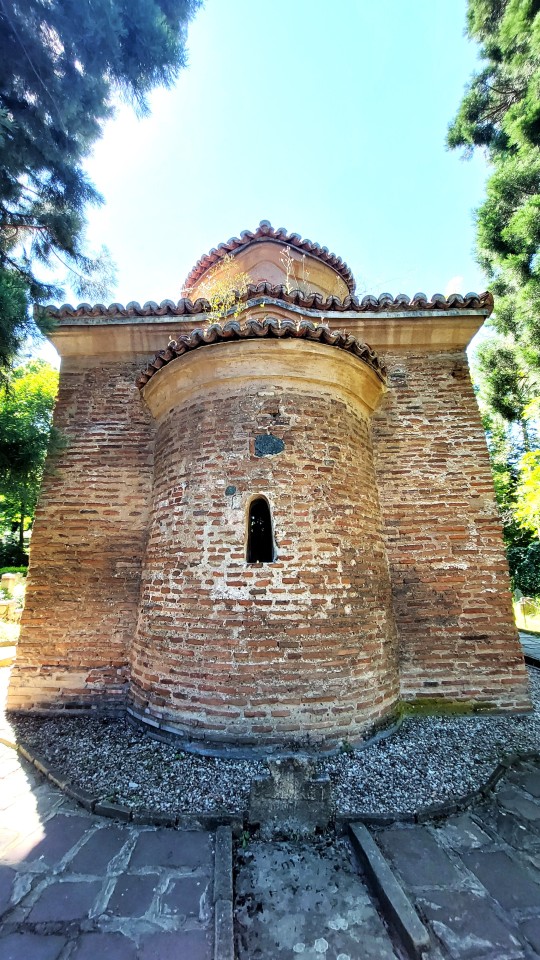
Boyana Kirche
Im Angesicht dessen vergesse ich jegliche frömmelnde Überlieferung, jedes gutgemeinte, allzu konservative Dogma. Hier ist ein Mensch abgebildet, wohl ahnend, welches Los ihm beschieden ist. Natürlich herrscht in dem winzigen Innenraum strengstes Foto-Verbot, das raunt mir mein (hier unerlässlicher) Guide ins Ohr. Ich nicke. Er fragt, ob er sonst noch etwas für mich tun könne. Ich nicke abermals, positioniere ihn mit beiden Händen so, dass sein massiger Körper die neugierigen Blicke des Kustos verdeckt, sodass ich blindwütig alles abfotografiere, dass mir gerade vor die Linse kommt. Einmaliges darf sich nicht der Begehr meiner Leserschaft entziehen, schon gar nicht der Anblick seiner Heiligkeit, Gott aller Christen, Juden und Protestanten, der Herr allen Lebens. Dann packe ich meine Siebensachen zusammen, verabschiede mich freundlich vom Museumswärter, puffe meinem Führer freundschaftlich in die Hüfte und verlasse schlechten Gewissens den heiligen Ort. Draußen im Garten überprüfe ich das Ergebnis meiner Raubkunst. Was ich sehe, treibt mir die Tränen der Rührung in die Augen. Ein etwa 17-Jähriger blickt mich an: fragend, zweifelnd – beinahe lächelnd.

Die bemalte Kirche
#michael schottenberg#schotti#schotti unterwegs#schotti to go#orf#studio 2#Bulgarien#Sofia#Kirchen#Orthodxe Kirche#Ikonen#Alexander Nevski#Kyrill#Method#Kyrill & Method#Zar Samuil#Byzantinisch#Boyana Kirche#Basilika Sveta Sophia
3 notes
·
View notes
Text
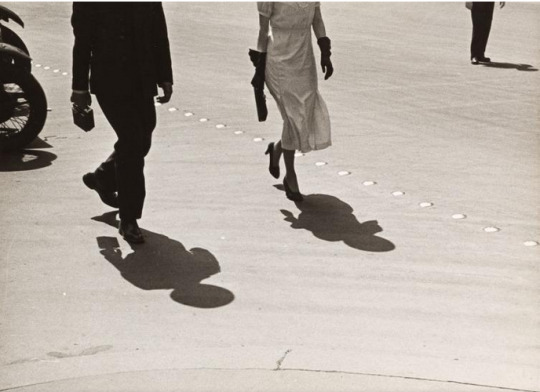
Lothar Rübelt
Michaeler Platz
Vienna 1932
45 notes
·
View notes
Text
Südengland 2023 - Tag 8
Ladies and Gentlemen!
Da habe ich wohl doch etwas zu viel versprochen, über unsere Tour mit einem Duck-Mobil-Boot.
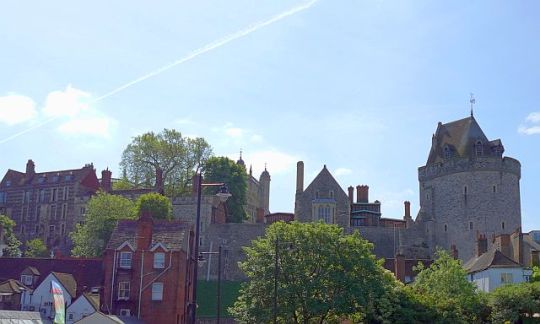
In der Thames Street, gleich hinter dem Windsor Castle, sollen merkwürdige Gefährte stehen, die auf Kundschaft warten. Sie sind gelb, sehen aus wie kleine Busse, können aber wesentlich mehr als nur auf Straßen herumzufahren: Diese Fahrzeuge können auch problemlos auf der Themse schwimmen.
Die Amphibienfahrzeuge, die im 2. Weltkrieg entwickelt und bei der Invasion der normannischen Küste 1944 eingesetzt wurden, sind seit 2003 im Londoner Straßenbild zu finden. Vorbild waren die Boston Duck Tours, die in der nord-ostamerikanischen Stadt schon länger bei Touristen sehr beliebt sind.

Die Touren starten von 10 Uhr morgens - allerdings nur nicht heute.
Wir kamen früh an der Bushaltestelle, vor dem Theatre Royal,m an, um auf den „Entenbus“ zu warten. Auf der Windsor Duck-Tour-Website sind freundlicherweise alle Orte aufgelistet, an denen die Gäste parken können.

Wir entschieden uns dafür, auf dem River St Car Park Parkplatz zu parken, da dies der nächstgelegene Parkplatz zur Haltestelle ist und obendrein noch der preisgünstigste. Parken in Windsor ist teuer!

Zur Haltestelle sind es nur noch 150 Meter und wir nahmen in freudiger Erwartung Platz. Wer fährt/schwimmt schon mit einem Duck-Mobil?
Die Frage kann schnell beantwortet werden: Wir jedenfalls nicht!
Der Entenbus kam nicht. Dabei hatten wir doch gestern erst noch eine Erinnerungs-Email bekommen, mit der Aufforderung bloß pünktlich zu sein und 15 Minuten vorher einzutreffen.
Ich zückte mein Mobiltelefon und rief die Firma, über die an der Haltestelle vermerkte Telefonnummer, an. Der freundliche Herr am anderen Ende der Leitung erklärte mir: heute finden leider gar keine Touren statt - alle gecancelt.
Ach, wie schön! Was machen wir denn jetzt mit unserem angebrochenen Tag? Erst einmal runter zur Themse Promenade und schauen, was es noch so gibt ...
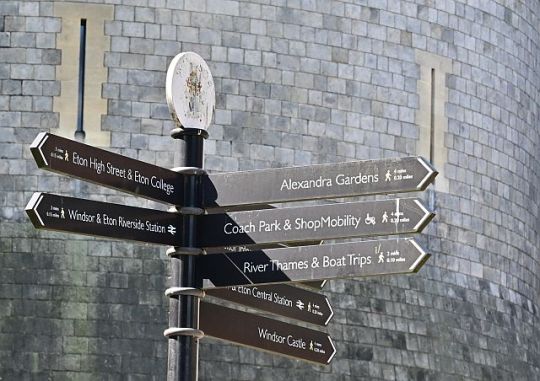
Ach, guck, da werden doch Bootstouren auf der Themse angeboten. Also, rein in den nächsten Ticketshop und kurzer Hand eine Tour für das nächste Boot gebucht.

Der Andrang hielt sich in Grenzen und wahrscheinlich war das auch der Grund für den Ausfall unserer eigentlich gebuchten Tour: zu wenig Gäste.

So geht es auch hier gerade einmal mit 7 Männekes auf Themse Sightseeing. Wir schipperten zunächst in Richtung Westen, nach Maidenhead.

Der Fluss war wie aus dem Bilderbuch ruhig, der Himmel strahlend blau und ganz leicht bewölkt.

Dieser Teil des Flusses ist nur etwa 6 Fuß tief. Familien und kläffende Hunde planschen herum, dümpeln neben den Schwänen. Die Schwäne gehören übrigens King Charles, davor natürlich der Queen.

Alle wilden Schwäne im Königreich sind Besitz der Monarchen, so will es ein altes Vorrecht. Den Schwanen-Zensus auf der Themse gibt es schon seit dem 12. Jahrhundert. Damals entschied die Krone, dass Schwäne königlicher Besitz sein sollten. „Zu dieser Zeit galten Schwäne als köstliche Speise bei Banketten und Festen“, erklärte der Palast dazu.
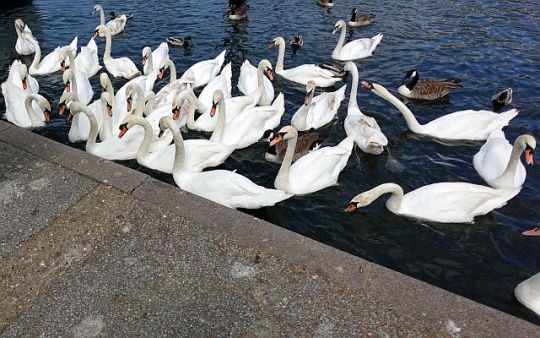
Sie werden allerdings seit dem 19. Jahrhundert nicht mehr verzehrt, seit 35 Jahren sind die Schwäne außerdem geschützt; es ist verboten, sie zu jagen. Dank der regelmäßigen Zählung weiß man, dass etwa 1000 bis 1200 Schwäne auf der Themse unterwegs sind und im vergangenen Jahr 120 Jungschwäne markiert wurden.
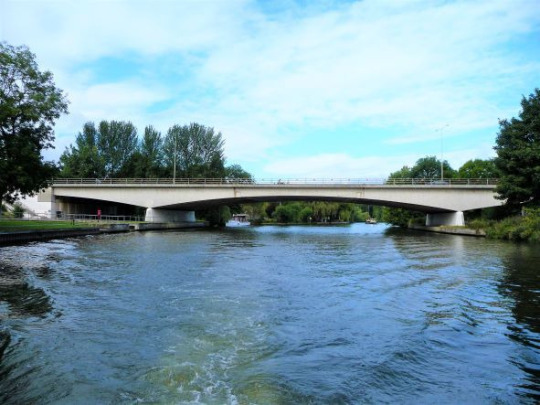
Wir unterfahren eine Überführung des Londoner Autobahnrings (die Queen Elisabeth Bridge aus dem Jahre 1966) und die Passagierflugzeuge, die im Tiefflug Heathrow anpeilen, erscheinen wie aus einer anderen Welt.
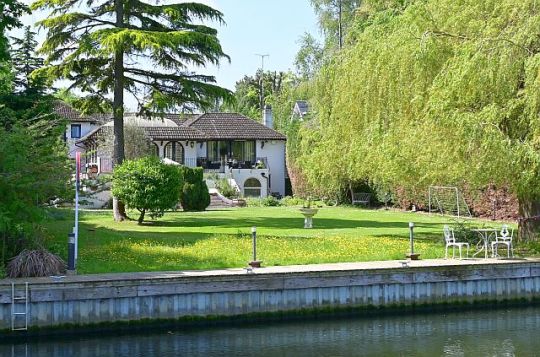
Die Fahrt führte uns weiter flussaufwärts, vorbei an Millionen-Pfund-Villen. In diesen Villen wohnen und wohnen unter anderem sehr prominente Menschen: der Musiker Jimmy Page von Led Zeppelin, der Schauspieler Michael Cain, die australische Sängerin Natalie Imbruglia, um nur einige zu nennen.

Wir erfahren, dass Miss Imbruglia ihr Anwesen, vor über 20 Jahren, zum Schnäppchenpreis (unter einer Million) kaufte und heute der Wert um die 20 Millionen Pfund liegt. Das nenne ich mal eine Rendite!
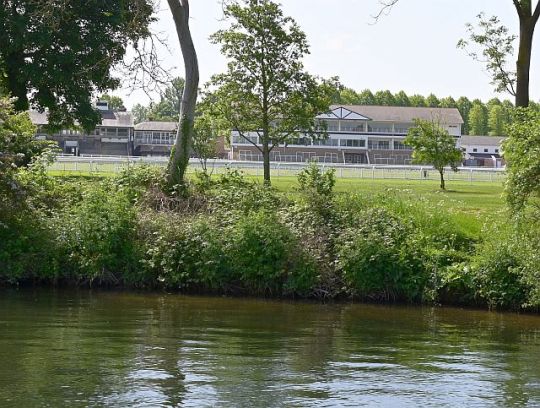
Gleich dahinter, auf einer eigenen Insel, schließt sich die berühmte Pferderennbahn Royal Windsor Racecourse an. Einzigartig ist die Möglichkeit, stilvoll mit dem Flussboot vom Stadtzentrum von Windsor aus auf die 165 Hektar große Insel anzureisen. Selbstverständlich gibt es für die königliche Familie und andere wichtige Personen private Anlegestege.
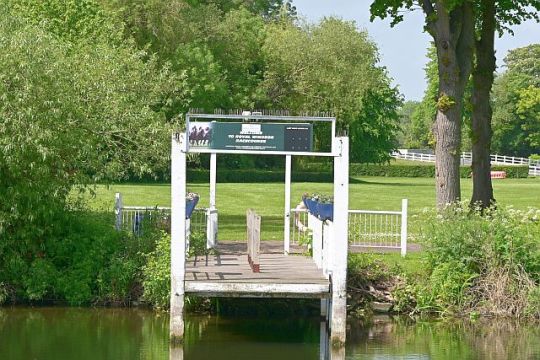
Rechts und links der Themse liegen Hausboote, deren Anzahl stetig zunimmt. Wegen der seit Jahren explodierenden Immobilienpreisen flüchten viele Einwohner auf das Wasser, da sie sich die Preise nicht mehr leisten können oder wollen.

Beispielsweise wohnt “unsere” ARD Auslandskorrespondentin und Studioleiterin in London, Annette Dittert, ebenfalls in einem Hausboot auf der Themse. Gelegentlich berichtet sie auch von dort.

Die Fahrt führt bis zur alten Holzschleuse Boveney Lock. Diese Schleuse ist eine der beliebtesten und meist fotografierten Schleusen der Themse.
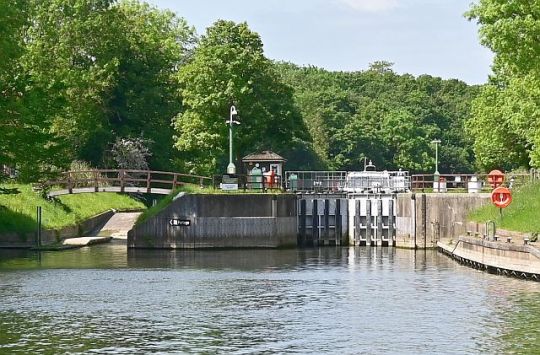
Über die Ursprünge des Weilers Boveney ist wenig bekannt, obwohl man weiß, dass es hier eine alte Fischerei aus dem Jahr 1201 gab. Die Schleuse selbst wurde erst 1838 gebaut.

An der Schleuse und dem parallel dazu liegendem Wehr dreht das Schiff um und wir fahren wieder zurück nach Windsor. Es gibt einen Punkt in der Tour, an dem man einen phantastischen Blick auf Windsor Castle hat!
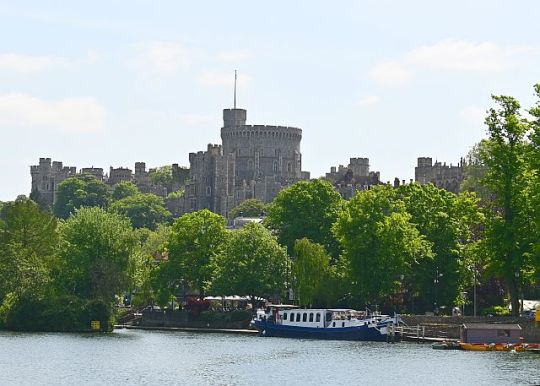
Wir kommen wir kurz vor die Windsor & Eton Bridge und drehen dann bei. An dieser strategischen Stelle befindet sich durchgängig bereits seit 1171 eine Brücke, die als Toll-Bridge zur Erhebung von Mautgebühren genutzt wurde.
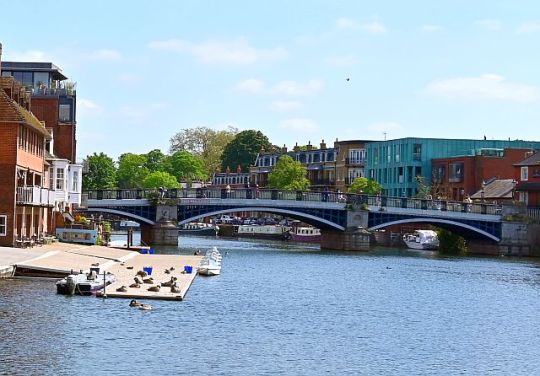
Die aktuelle Brücke stammt allerdings auch schon aus dem Jahr 1822 und ist seit 1970 für den Verkehr gesperrt, da der moderne Straßenverkehr der Brücke zu sehr zusetzte. Heute dürfen nur noch Fußgänger die Themse darüber passieren.

Wir konnten durch diese Tour wieder einiges Neues lernen, zum Beispiel auch die Tatsache, dass die Windsor Railway Bridge auf Geheiß von Queen Victoria gebaut wurde, die eine private Zugverbindung von London zum Schloss Windsor “benötigte”. Die Brücke wurde von Brunel entworfen und zwischen 1847-48 erbaut.

Wir verlassen die Themse wieder und laufen zurück zu unserem Auto. Wir fahren einmal durch Windsor zurück, bis zu unserer Unterkunft.

Diese liegt etwa 1,3 Km südlich des Castles, in einem Appartement Komplex in dem ausschließlich Ferienwohnungen untergebracht sind. Insgesamt gibt es 8 Wohneinheiten.
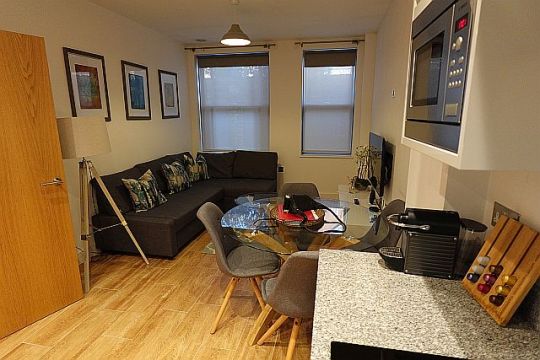
Und wie schon in Canterbury, punktet auch diese Unterkunft mit einem eigenen Parkplatz, der im Innenhof liegt.

Sehr nett, der kleine Präsentkorb, der zur Begrüßung bei unserer Anreise in der Küche stand.

Noch aufmerksamer wäre es allerdings gewesen, wenn die Butter nicht schon 5 Wochen abgelaufen und schimmelig wäre.
Good Night!
Angie, Micha and Mr. Bunnybear (Hasenbär)
7 notes
·
View notes
Photo

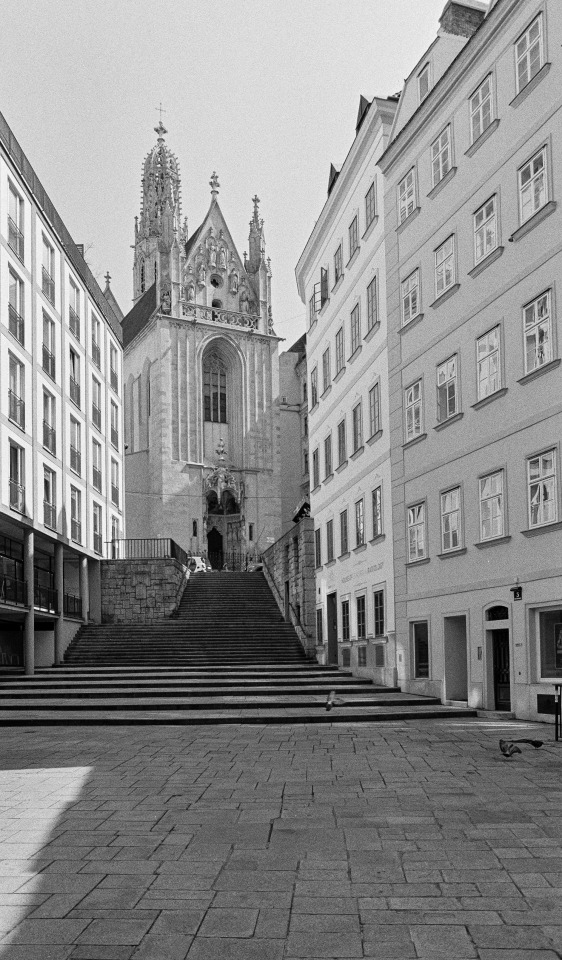
passauer platz // wien altstadt
gothic meets baroque and mid-century modern in the heart of vienna. this church, which is now hidden in the middle of the city, used to serve as a landmark for skipper on the danube because it was located on an arm of the river. for me, the perron is the most beautiful in all of vienna, a magnificent backdrop but not at all overrun by the streams of tourists that squeeze through the streets and alleys only a short distance away. here you can still sit on the steps with a book and a coffee.
catholic church “maria am gestade”
built from 1330 by michael knab & peter prachatitz
concordia hof
architects: max feller, eugen wörle und felix hasenörl
completion: 1958
analog and digital photos
film: ilford hp5 plus
camera: canon a-1 with canon fd 28m
#moderne#architecture#architecture photography#urban#urban photography#black and white photography#monochrome#iilford hp5#canon a1#vienna#wien#wien altstadt#vienna old city#max fellner#eugen wörle#felix hasenörle#michael knab#peter prachatitz#wiener nachkriegsmoderne#österreichische nachkriegsmoderne#wiener nachkriegsarchitektur#österreichische nachkriegsarchitektur#post war modern#austria post war modern#vienna post war modern#vienna post war architecture#mid century modern#maria am gestade#gothic architecture#gothic
13 notes
·
View notes
Text

A letter written by Wilfred Douglas, one of Windenburg's most famous generals, thought lost for decades is finally going on display at the Douglas-Lee Royal Museum in Olde Platz. The letter is believed to have been stolen from the York State Archive, according to a news release from Michael Francis Gilbert, secretary of the Commonwealth.
Douglas wrote the letter to the Marquis of Newsoms, a Brindleton Bay aristocrat who served as a general in the Continental Port Army. Dated July 28, 1828, the letter resulted in Windenburg sending troops to Port Hastings to bolster the embattled Brindleton Bay forces.
Douglas, who was then the captain of a Sable Square artillery company, sent the letter during the end of the Battle of Boats. In the letter, Douglas warned the Marquis of "enemy" forces coming to Port Hastings and endangering Brindleton Bay troops. The Marquis was aiding Windenburg in the fight against the Sulani.

An archive employee who stole the letter was arrested in 1971 and found to have sold it, alongside other documents from Windenburg's history, to rare books dealers.
In March 2019, the letter emerged at an auction house in York, Windenburg before coming into the custody of the Ministry of Internal Affairs the following year.
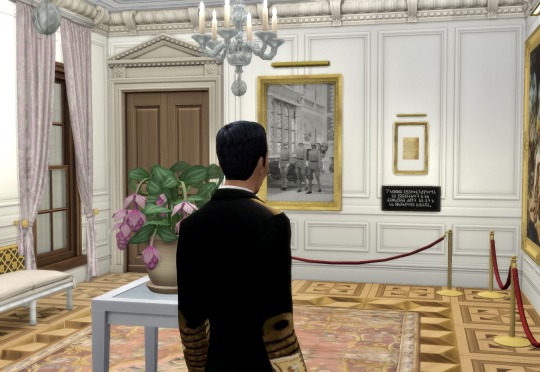
The Museum's Trooping the Colors exhibit will be the first opportunity the public will have to see the letter. King George, Royal patron of the museum, previewed the exhibit ahead of its public opening later this week.
The exhibit will also include other original documents from the 19th century, like a photograph of King Albert II with Captain Douglas and Captain Hawkins taken during the Battle of Boats, while the trio were at Mayfield Castle in Brindleton Bay.
#TS4#ts4 royalty#simblr#ts4 story#ts4 legacy#sims 4 legacy#the sims 4 story#ts4 simblr#sims 4 royalty#ts4 royal simblr#sims 4 monarchy#ts4 museum opening#sims 4 story#sims 4 simblr#the sims legacy
11 notes
·
View notes
Note
Hi Mao, (ich mag deine Werke sehr) also ich habe mich vor einem Vorfall im Skilager erinnert, der mich dann dazu gebracht hat darüber nachzudenken "Was wenn es Michael Kaiser(Blue lock) passiert wäre". Also ich hatte mal Skilager vor ein paar Monaten und da haben wir halt Ski fahren gelernt und ich hab halt am Anfang verkackt und hab später denn Dreh rausgekriegt. Am vorletzten Tag beim Frühstück haben die Lehrer erklärt was wir machen. Meine Gruppe war die erste die los musste. Da ist sogar einer bei einer anderen Gruppe mitfahren musste weil er den ersten Bus verpasst hat in dem er drin war. Also die Lehrerin sagte das wir unsere Schuhe in Säcke packen was wir halt alle getan haben nur ein Schüler hat einen Sack mitgenommen und der Rest wurde dann an der Jugendherberge vergessen, später stellt es sich heraus das dem zweiten Bus gesagt wurde das man seine Schuhe selber mitnehmen soll und nicht in den Sack stecken. Dann später als wir unsere Skier zurück geben sollten und unsere Schuhe anziehen sollten fanden die Personen im ersten Bus ihre Schuhe nicht(außer die die den Sack mitgenommen haben) wir haben alles abgesucht und dachten das sie gestohlen worden sind. Da uns nichts eingefallen ist mussten wir mit unseren Socken (oder andere Schuhe ausleihen) durch die nassen Pfützen und dem kalten Schnee zum Bus sprinten. Meine Socken waren dann klitschnass. Einer meiner Freunde mussten sogar dabei zurück laufen weil eine Lehrerin ihn zurück gerufen hat dann stand er da und hat sich die Füsse abgefroren. Im Bus haben wir erfahren das unsere Schuhe von ersten Bus noch in der Jugendherberge sind und nicht gestohlen wurden. Am Ende bei der Jugendherberge hat der Bus nicht vor dem Gebäude geparkt und wir mussten alle hoch laufen natürlich hab ich dann rumgeschrien das die anderen Platz machen sollten weil ich grad angerannt kam da meine Füsse mir gleich abfrierten. In der Jugendherberge bin ich dann in mein Zimmer, das ich mit anderen Mädchen geteilt hab, reingerannt. Da lag eine meiner Freundinnen die verletzt war weil sie einen Unfall hatte bei der Skipiste und sie dann noch gesagt hat das sie hier bleiben will, und hatte mich gefragt was passiert ist bei der Piste also hab ich ihr dann alles gesagt. Währenddessen hab ich meine nassen Socken ausgezogen und sie ihr dann ausversehen ins Gesicht geworfen und dann hat sie angefangen herum zu kreischen. War voll witzig.
Aber jetzt kommts imagine Kaiser wäre das hier alles passiert und Ness würde dann die Rolle meiner Freundin spielen und Noah wäre diese eine Lehrerin die ich erwähnt habe. Kaiser würde danach rummäckern das seine "teuren" Socken nass geworden sind und voller Dreck sind.
Du musst mir nichts darüber antworten aber ich wollte es dir mitteilen weil es mir wieder eingefallen ist und es sehr lustig war.
Danke dass du dir die Zeit genommen hast dir das zu lesen
Schönen Tag noch.
Das klingt nach so ner schlimmen experience 😭 NASSE UND KALTE SOCKEN???😭😭 Honestly, ich glaube Ness würde Kaiser anbieten ihn zu tragen, damit er nicht laufen muss HAHAHAHAH
(Btw, danke <3)
2 notes
·
View notes
Text
4 July 1997 - Zürich after 20+ years - Züri Fäscht - Polybahn - Spätzle and Hürlimann for supper
Friday 4 July 1997
Hi everyone, Grüezi mitenand e buon giorno!
Welcome to my second international journey which takes maybe two and a half days. I would go from München Hbf to Zürich HB without changing trains, on Saturday 5th July take a train in the morning from Zürich HB to Milano Centrale, and in the afternoon on Sunday the 6th July I would take the train from Milano Centrale to München Hbf, changing direction at Verona Porta Nuova, going through Trentino Alto-Adige / Südtirol past Brenner, Innsbruck, Kufstein, Rosenheim and exiting at München Ostbahnhof. I stayed at hostels, sharing bedrooms with strangers. I had my youth hostel membership card with me so I would not have to pay extra.
On Thursday 3rd July I made sure that I had all my train tickets with me, including the sections between Lindau Hbf and St. Margrethen SG, as well as Brenner to Kufstein. I know of the station Lochau-Hörbranz, just right across the border past the future station Lindau Reutin (in operation since December 2020), but the EuroCity train did not stop there, nor did it stop at Lustenau, the final S-Bahn stop along the Bregenz S-Bahn line S3, before crossing into Switzerland. It would make little to no difference anyway. I listened to the radio the night before, listening to "Lonely" by Nana, an ad for an upcoming Michael Jackson concert somewhere near Kieferngarten/Freimann, "A girl like you" by Edwyn Collins, "Sultans of swing" by Dire Straits, and in the morning when I woke up about 5:45 AM, I tuned in Bayern 3. There was a contest to win a ticket to the Michael Jackson concert for Sunday evening the 6th July 1997. The song that was garbled was "Billie Jean", and the contestant had to play about ten seconds of it on their own radio or tape player - I could not play along because I did not have a copy of "Thriller" with me, either tape or CD. Oh well.
It was Friday morning 4th of July. I was already awake by 6 AM. I took a shower, made some sandwiches and coffee in one bottle and soda mix in another, and then left for the St. Quirin Platz bus stop. I took the bus 99 to Silberhornstraße, the U Bahn to Hauptbahnhof and I was on the 8:05 AM train from München Hbf to Zürich HB. I made sure that I had marked 04 07 in my Eurail Pass, so that the conductor could see it and cancel it for the rest of the day. I was in second class, so I was towards the front part of the train past the dining car. The second class car was okay, not exactly spacious. The train did not stop at München-Pasing at all. It did not stop until Buchloe. Back in 1997, there was no electrification of any kind between Geltendorf and Lindau Hbf. I did not know this until the train passed Geltendorf and was wondering, where is the catenary? It has been a long time since a mast had been spotted. It turned out that the locomotives were DB-218 diesel. The train would stop in Buchloe, Memmingen and Lindau Hbf. Only Lindau Hbf had electrification that came from Lochau-Hörbranz in Austria, and Lindau Reutin as a passenger station had not been built yet. For that reason, the train had to not only change direction, but because of the non-electrified section between Lindau Hbf and Geltendorf, the train had to switch from a diesel locomotive to an electric locomotive in order to continue to Zürich HB. The weather was not particularly friendly, being a rainy day and temperatures in the mid 60s / about 17 to 19 C, yet it was fair enough for the train to make its stops on time in Germany.
After the train left Lindau Hbf, I turned on the radio and tried to listen to Bayern 3 and Radio Vorarlberg as well as the DRS (which has since become SRF). My analog radio had its difficulties receiving stations, as it was not the digitally tuned HS-JS 475 model that I would buy about a year later. I was able to pick up songs like "I don't want to be alone" by the Bee-Gees and "Down by the schoolyard" by Paul Simon. I even was able to hear "Lazy Sunday afternoon" by the Small Faces (prior to Rod Stewart joining) and "Ruby Tuesday" by Rod Stewart, originally by the Rolling Stones.
The train from Lindau Hbf to Zürich HB was using a SBB class 421 electric locomotive for the remainder of the journey. Between Lindau and Bregenz, border checks were already conducted. The first stop after Lindau was Bregenz Hbf. It was a six track through-station with an overpass, one to the park and Seebühne venue, the other way to the taxi stand and Möhrenbräu restaurant and pub. I stepped out for about a minute or so, and was able to take a photo before boarding the train before it left for St. Margrethen via Lustenau. I could clearly notice that the clouds to the north of Bregenz were gathering. The train made a southward and then a westward journey past Lustenau. It crossed a bridge over the Rhine. A minute later the train arrived in St. Margrethen. The train had to stop for about ten minutes to perform passport checks. Back then, neither Austria nor Switzerland were part of the Schengen Agreement, and passport checks until mid-spring 2009 were mandatory between the EU countries and Switzerland. EU membership had little to no bearing before or after.
The train continued between St. Margrethen, St. Gallen, Winterthur without a stop in the canton of Thurgau (connection to Frauenfeld TG were available at Winterthur and points in between), Zürich Airport which was the only underground long-distance rail station, and past Oerlikon, Zürich HB. The train arrived around 12:25 PM. I had been to Zürich HB as early as 1976 with both of my parents, so returning 21 years by myself seemed a bit daunting at first.
It should be noted, that in Swiss written German, that place names generally do not start with Ä, Ö or Ü. And they never contain the ß letter. Instead, place names start as Ae for Ä, Oe for Ö and Ue for Ü. Anywhere that in Germany or Austria that would contain an ß, would have instead “ss”. In July 1998 when I returned, I would visit Uetliberg, and again in August 1998 the day after the Street Parade before going back to München.
I needed to withdraw some money, maybe 100 CHF at the time. The ATM at Zürich HB was not working correctly, so I took my ATM card, bought a day pass for the Zürich tram system, at that time just 7.20 CHF and valid for 24 hours after purchase, then took the tram to Paradeplatz where there was an ATM. I successfully withdrew 100 CHF from my bank account. Then I needed to find a place to put my luggage. I thought I would remember the location of the youth hostel, and that it would be on Mutschellenstrasse towards the tram stop Morgental. Sadly I had forgotten that detail since I left the Youth Hostel guide at my home and back then I did not even have a cellphone, so using Google would have been out of the question. I did however find a hostel, and it was called the City Backpacker, located at the Schweizerhofgasse, upstairs on top of a Spaghetti Factory with a solid black German Shepherd logo. The reception was open and the shared room price was around 27 Francs per bed, quite a bargain considering that Zürich is an expensive city to visit and live in. The Youth Hostel in Morgental was asking a similar price. Breakfast was not included in the overnight price. At least here there was no "curfew", no lockout time in particular, but quiet time was 10 PM to 6 AM.
I took the tram from Helmhaus to Central, and rode the Polybahn up only, not down. The Polybahn accepts short trip tickets, and a VBZ day pass would definitely be accepted. At the top of the Polybahn, was the Eidgenössische Technische Hochschule, or Confederate Technical University of Zürich. I remember a year later returning to make a selfie with a different camera, not the Konica that I had at the time.
I walked to the Universitätsspital Zürich tram stop and took a tram to Seilbahn Rigiblick. I did not know at the time that there was a secret U Bahn in Zürich, with only lines 7 and 9 between Milchbuck to Schwamendinger Platz, and I was not interested in that at the time, in fact, I did not visit it until September 2000, probably two visits hence. I boarded the cable car and found that there was no driver. Instead there was a set of buttons, up to the top station Rigiblick with a bus connection. I picked the top station. At Rigiblick, I boarded the bus line 39. At the time this line was operated with a Renault Trafic minivan, with manual transmission. The driver announced all the stops from Rigiblick to Klösterli. I stayed on the bus until I arrived at Klösterli next to the zoo. We had passed the Zoo tram stop, so I could have returned by tram lines 5 or 6, but I chose to explore Klösterli before taking the bus back. I looked at the menu for the Klösterli restaurant but found the prices to be too high for my liking. I took the bus back to Rigiblick and then the cable car back to the bottom.
One bit of trivia for the Fluntern - Zoo district, author James Joyce was buried in the Fluntern cemetery. He had lived in Zürich for a while, despite having also lived in Dublin where “Ulysses” had taken place.
I took a tram from Seilbahn Rigiblick Talstation through Unterstrass and on to Oerlikon. I decided to take an S-Bahn to Stettbach, hoping to exit there. However I boarded a S-5 train to Uster, outside of Zürich. The train stopped at Hardbrücke, went underground to the tracks 21 to 24, and since the Löwenstrasse station had opened in the 2010s, it is now called tracks 41 to 44, then on to an open cut at Stadelhofen, and did not stop until Uster. The train went right through Stettbach. I had heard about Stettbach S Bahn station through the Zürich Marco Polo guide, which I should have bought but felt a bit too frugal to buy it until Summer 1998 when I returned. I walked around the Uster S Bahn station and boarded the next train to Zürich. My Eurail pass would have been valid for the entire S-Bahn network in second class, as far as Schaffhausen if I were so bold to want to go there that day.
When I returned to Zürich, I exited at Stadelhofen. Between Bellevueplatz, the Opernhaus and Bürkliplatz, there was the Züri Fäscht going on. The majority of the music played there, was New Orleans jazz and some rapping. I remember even going to one stage where there was a singer singing his own version of "Amazing Grace" which included a rap. I had recorded his singing and it was pretty good. For food, some places were selling Cajun cuisine, even jambalaya. Since I did not go to Switzerland to have Cajun food, I had to take a pass on it, sadly.
I had walked along the Bahnhofstrasse, hoping to find the Neue Schweizerische Börse, which at the time I did not know, was actually at the southwest end of the Selnau rail station. I did not find anything at the time, that I wanted to particularly buy, nor did I find anything to eat just yet. So I went back to the hostel to rest up a bit.
About 9 PM I left the hostel and took a line 32 trolleybus to Farbhof. I wanted to just ride along, to see if there was anywhere to eat for cheap. I was a bit disappointed. So I went back to Central and the Niederdorferstrasse. I found one place called the Brasserie Johanniter which was still serving warm meals. At the time, it was serving Spätzle with ham, cheese and onions. I ordered a half liter of Hürlimann lager to go with that. It did not cost too much, maybe under 30 CHF. I used my debit card to pay. I turned on my radio and recorded something from Radio Z or some similar FM station. Some songs I recorded included "Samba de Janeiro", "Firestarter" and "Insomnia". Those were songs that in 1997 were in the top charts.
I walked back to the Spaghetti Factory and went upstairs to my room. I think four others were in the same room. I went to sleep and made a note to wake up by 6:30 AM to leave the next morning for Milan.
I hope you will join me for tomorrow's adventure crossing the Alps through the Gotthard Pass between Göschenen and Airolo, and going up the Ceneri grade. Even with the bad weather, it should be an enjoyable journey all the same.
bis morgen, a domani!
#Grüezi#München Hbf#Buchloe#Geltendorf#München Pasing#Memmingen#EC92#Lindau Hbf#Lindau Insel#Lindau Reutin#Michael Jackson#St. Margrethen#St. Gallen#Winterthur#Zürich#Flughafen#Airport#HB#UBS#Paradeplatz#Bürkliplatz#Stettbach#Stadelhofen#Rigiblickbahn#Fluntern#James Joyce#Oerlikon#Selnau#Bahnhofstrasse#Züri Fäscht
2 notes
·
View notes
Link
0 notes
Text
Die geringe Wertschätzung der Nukhba für israelisches Leben beruht auf vier miteinander verbundenen Säulen, wie Michael Milhtein in einer Analyse für YNet schreibt:
»Die extremistische islamische Sichtweise, die den Feind als ein zu vernichtendes Objekt und nicht als Mitmenschen ansieht,
der tiefgreifende Einfluss globaler dschihadistischer Ideen auf Hamas-Kämpfer (Materialien von Abdallah Azam, dem palästinensischen religiösen Mentor Bin Ladens, wurden bei Leichen von Terroristen des Massakers vom 7. Oktober gefunden),
die antikoloniale Denkweise, die den Unterdrückten das Recht zugesteht, auf uneingeschränkte Gewalt zurückzugreifen,
und der Einfluss sozialer Netzwerke, insbesondere TikTok, das im Leben der palästinensischen Generation Z, die das Massaker anführte, einen zentralen Platz einnimmt.«
[...] Die tiefe ideologische Indoktrination, die hinter den Kriegsverbrechen steht, wurde durch extremistische religiöse Lehren erreicht, die den Nukhba-Mitgliedern vermittelt wurden. Während des Kriegs in Gaza wurden viele Bücher mit solchen Richtlinien beschlagnahmt, die das Weltbild der Hamas veranschaulichen: Diese Ideologie betrachtet Geiseln, insbesondere Frauen, als Beute, erlaubt die Folterung und Tötung von Gefangenen, die gänzlich ihrer Menschlichkeit beraubt werden, und betrachtet alle Israelis als Feinde.
Das Buch Fatwas (deutsch: Rechtsgutachten), herausgegeben vom Schura-Rat der Hamas in Gaza unter der Leitung vom stellvertretenden Vorsitzenden des palästinensischen Parlaments, Ahmed Bahar, der während des Kriegs getötet wurde, erklärt, warum alle Israelis legitime Ziele seien.
1 note
·
View note
Link
0 notes
Video
🌟10th Anniversary Issue 41 Pre-Orders now open! 🌟https://store.beautifulbizarre.net/product/issue-41-pre-order/
Beautiful Bizarre Magazine is a leading publication for contemporary art lovers, featuring in-depth interviews and profiles of leading and emerging visual and wearable artists from around the world. Each issue offers informative, inspiring, and thought-provoking content, perfect for artists, artisan fashion designers, collectors, curators, galleries, and anyone looking to stay up-to-date on the latest trends in the contemporary art world.
Inside Issue 41
Exclusive In-Depth Interviews: Michael Parkes [cover artist], Tamura Yoshiyasu, Tania Rivilis, Andrew Hem.
Articles: Roxanne Sauriol Hauenherm, Paolo Puck, Known as Myself, Yuki T Photography, Ilya Zomb.
10 Year’s of Beautiful Bizarre Magazine: Interview with Beautiful Bizarre Magazine’s Co-Founder and Editor-in-Chief who speaks to us about how the magazine began, how it has grown and evolved over the last decade. Her challenges, successes, learning, and her journey thus far.
Curator’s Wishlist: Martin & Louise McIntosh, Directors of Outre Gallery in Melbourne, Australia share what they would like to add to their personal collection.
Collectors Profile: Kim Larson & Bradley Platz, Directors of Modern Eden Gallery speak to us about their personal collection and what motivates them to collect contemporary art.
Lookbook: Full page reproductions of Nona Limmen’s dark surreal photography.
Quick Q&A: Lou Benesch, Loputyn, Petite Doll, Karen Turner, and Win Wallace [2022 Beautiful Bizarre Art Prize, Honourable Mention], all respond to the same 4 questions which delve into their artistic practice:
How do you maintain your individuality as an artist and avoid being influenced by others in your field?
Tell us about your earliest memories of creating art and when you first realized that you wanted to be an artist?
How do you balance your personal life with your art career while ensuring a healthy work/life balance?
How do experimentation and risk-taking play a role in your creative process?
Beautiful Bizarre Artist Directory: Discover exceptional, innovative and skilled artists from around the world with Beautiful Bizarre Artist Directory – the leading platform for connecting with top talent.
Inside this issue: Jon Ching, Adrian Cox, Iness Rychlik, Elizabeth Winnel, Ransom & Mitchell, Dawid Planeta, El Gato Chimney, Tran Nguyen, Daantje Bons, Troy Brooks, Hannah Yata, Mothmeister, Josh Dykgraaf, Reuben Negron, Amahi Mori, Stephanie Rew, Jeff Echevarria, Bill Mayer, Akishi Ueda, Adam Matano, Brian Viveros, Annie Stegg Gerard, Eunpyon, Marcela Bolivar, Lindsey Carr, Ebony Russell, Hannah Flowers, Theodora Capat, Erik Mark Sandberg, Sara Gallagher, Brittany Markert, Adrian Cox, Bill Mayer, Beth Mitchell, Aaron Mcpolin, Nicolas Bruno, Steven Kenny, Allison Reimold, Adam Matano, Hiroshi Hayakawa, Lexi Laine, Hannah Flowers, Ema Shin, Heidi Taillefer.
Some of our Favourite Things: We share some of our favourite artisan fashion designers including: Louise Gardiner Embroidery, Ellen Rococo, Yu Tanaka, Jingyi Xiexie, and Sandra Mansour.
Our Community: Our Instagram #beautifulbizarre community feature including: @candiceghaiphotography, @christina.ridgeway.art, @julyhendrix, @marieeve_proteau, @petulantpretty, @vasilisa.romanenko, @margosimms, @thisiscraves
—
#beautifulbizarre #artmagazine #art #photography #sculpture #digitalart #artisanfashion #couture #artinspiration
21 notes
·
View notes